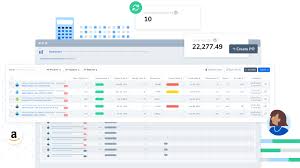Mastering Inventory Management on Amazon: A Comprehensive Guide to Tracking Levels and Restocking Products

In the dynamic world of e-commerce, efficient inventory management is the cornerstone of success for any seller, especially on platforms like Amazon. With millions of products available and customers expecting fast shipping times, tracking inventory levels and strategically restocking products is crucial to maintaining a competitive edge and maximizing profits. In this comprehensive guide, we will delve into the intricacies of inventory management on Amazon, providing detailed insights, strategies, and best practices to help sellers optimize their operations.
Understanding Inventory Management on Amazon
Before diving into the specifics of tracking inventory levels and restocking products, it’s essential to grasp the fundamentals of inventory management on Amazon. As a seller, you have the option to fulfill orders either through Fulfillment by Amazon (FBA) or Fulfillment by Merchant (FBM). With FBA, Amazon handles storage, packaging, and shipping, while with FBM, sellers manage these aspects themselves.
Importance of Tracking Inventory Levels
Accurate inventory tracking is critical for several reasons:
- Avoid Stockouts: Running out of stock can result in missed sales opportunities and damage to your seller metrics.
- Prevent Overstocking: Excess inventory ties up capital and storage space, leading to increased costs and potential storage fees.
- Optimize Replenishment: By monitoring inventory levels, sellers can identify trends, anticipate demand, and replenish stock strategically.
Strategies for Tracking Inventory Levels
Utilize Amazon Seller Central Tools
Amazon provides various tools and reports to help sellers track inventory levels effectively. These include:
- Inventory Dashboard: Offers a snapshot of current inventory levels, sales performance, and restock recommendations.
- Inventory Reports: Detailed reports that provide insights into inventory movement, including sales, returns, and remaining stock.
- Inventory Planning: Allows sellers to set up automated alerts and notifications for low inventory levels.
Implement Inventory Management Software
Third-party inventory management software can streamline and automate inventory tracking processes. These tools often integrate with Amazon Seller Central, providing advanced analytics, forecasting capabilities, and multi-channel inventory management.
Employ SKU and Barcode Systems
Assigning unique SKUs (Stock Keeping Units) and utilizing barcode systems for each product simplifies inventory tracking and reduces the risk of errors. Barcode scanners can be used to quickly update inventory levels and reconcile stock discrepancies.
Best Practices for Restocking Products
Restocking products efficiently requires careful planning and execution. Here are some best practices to consider:
Set Reorder Points and Lead Times
Determine optimal reorder points based on historical sales data, lead times from suppliers, and demand fluctuations. Factor in shipping times and production lead times to ensure timely replenishment.
Monitor Sales Velocity and Seasonality
Regularly analyze sales velocity and identify seasonal trends to adjust restocking strategies accordingly. Increase stock levels for high-demand periods and reduce inventory during slower seasons to minimize carrying costs.
Utilize Just-in-Time (JIT) Inventory
Implementing a just-in-time inventory strategy can help minimize holding costs and optimize cash flow. By closely aligning inventory levels with actual demand, sellers can reduce excess inventory and improve profitability.
Establish Relationships with Suppliers
Cultivate strong relationships with suppliers to negotiate favorable terms, secure priority access to stock, and receive early notifications of product availability. Consider diversifying suppliers to mitigate risks of supply chain disruptions.
Monitor Competitors and Market Trends
Stay informed about competitor pricing, product offerings, and market trends to make informed decisions about product selection and replenishment. Leverage competitive intelligence tools to track competitor activity and adjust pricing strategies accordingly.
Conclusion
Mastering inventory management on Amazon is essential for achieving long-term success as a seller. By implementing robust tracking systems, leveraging advanced tools and analytics, and adopting strategic restocking practices, sellers can optimize their operations, minimize costs, and capitalize on growth opportunities in the competitive e-commerce landscape. Continuously monitor performance metrics, iterate on strategies, and adapt to evolving market conditions to stay ahead of the curve and maximize profitability on Amazon.




